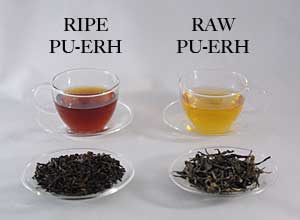Juil 142012
A. Pu-erh tea is classified in two types
- Sheng pu-erh, also referred to as raw or green pu-erh, is not oxidized. Sheng pu-erh is original pu-erh that is made to age many years before being consumed. Mao Cha is immature sheng pu-erh which needs correct storage and aging. It is less expensive than the aged sheng pu-erh. The difference is that the vintage variety can already be used immediately or can be permitted to age some more.
- In contrast, Shou pu-erh may be immediately consumed. It was discovered by innovative tea artisans sometime in the 1970s who wanted pu-erh tea that could be ready for use. Shou pu-erh or “black” pu-erh , also known as “ripe” or “cooked”, is oxidized to hasten its aging. It is much more affordable that Sheng pu-erh and can be consumed within 2 or 3 years

A comparison between raw and ripe Pu-erh:
Time required to achieve full fermentation:
| Raw | 20 to 30 years |
| Ripe | Several months |
Color of the Brew
| Raw | Between golden yellow to orange, varies based on age of the tea |
| Ripe | Dark chestnut |
| Raw | The brewed leaves of raw Pu-erh are more solid, soft and plump |
| Ripe | Leaves are usually not intact, color black and no longer soft. |
Taste Differences :
| Raw / Young Pu-erh | Has similar characteristics to green tea. As the tea ages, its character improves . Known for strong sensations in the mouth and lasting after taste |
| Ripe | Earthy and mild. Aged or ripe Pu-erh is smooth and tastes like ripened plum |
Popular Varieties of Pu-Erh Tea :
• Pu-Erh Tea Cake Red Dayi 7262 Menghai Tea Factory, 2003 (Black/Shou)
• Pu-Erh Tea Brick, Wild Leaves, Ke Yi Xing, 1990s (Green/Sheng)
• Pu-Erh Tuo Cha, Xiaguan Tuo, Xiaguan Tea Factory, 1990s (Green/Sheng)
• Emperor Pu-Erh Loose Leaf Tea 2000 (Black/Shou)
II. Pu-erh’s Origins
III. Production
IV. Types of Pu’erh and Brewing
VI. Pu-Erh Tea and Its Many Health Benefits
VII. Shaping and Packaging Methods
VIII. Storing Pu-Erh Tea
IX. Criteria For Choosing Pu-Erh Tea